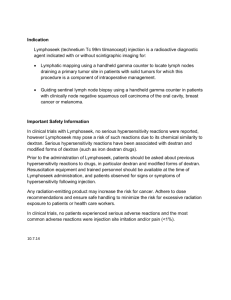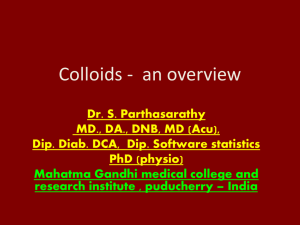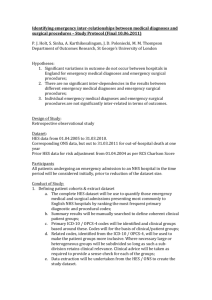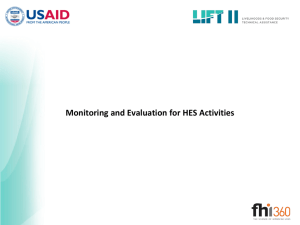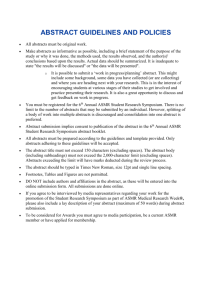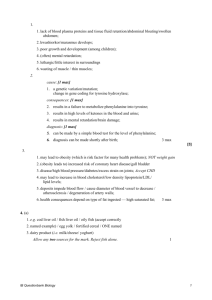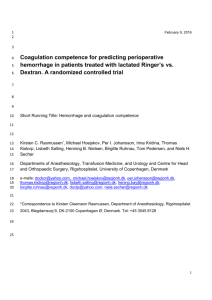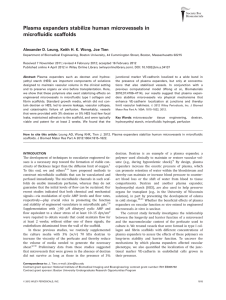Colloids
advertisement
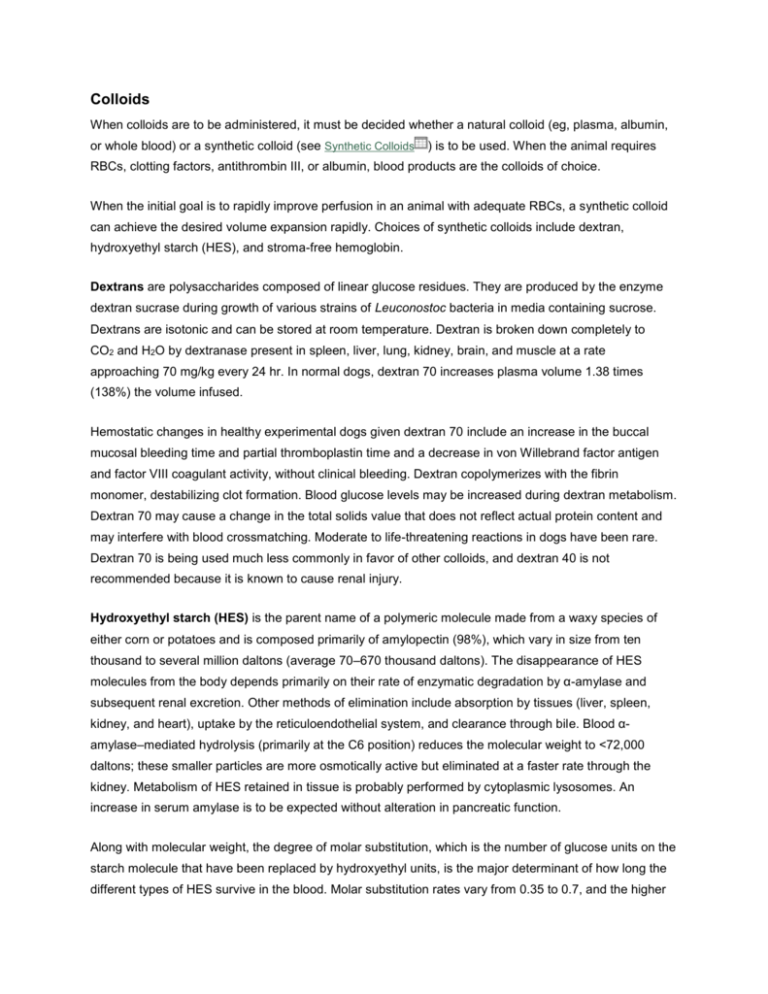
Colloids When colloids are to be administered, it must be decided whether a natural colloid (eg, plasma, albumin, or whole blood) or a synthetic colloid (see Synthetic Colloids ) is to be used. When the animal requires RBCs, clotting factors, antithrombin III, or albumin, blood products are the colloids of choice. When the initial goal is to rapidly improve perfusion in an animal with adequate RBCs, a synthetic colloid can achieve the desired volume expansion rapidly. Choices of synthetic colloids include dextran, hydroxyethyl starch (HES), and stroma-free hemoglobin. Dextrans are polysaccharides composed of linear glucose residues. They are produced by the enzyme dextran sucrase during growth of various strains of Leuconostoc bacteria in media containing sucrose. Dextrans are isotonic and can be stored at room temperature. Dextran is broken down completely to CO2 and H2O by dextranase present in spleen, liver, lung, kidney, brain, and muscle at a rate approaching 70 mg/kg every 24 hr. In normal dogs, dextran 70 increases plasma volume 1.38 times (138%) the volume infused. Hemostatic changes in healthy experimental dogs given dextran 70 include an increase in the buccal mucosal bleeding time and partial thromboplastin time and a decrease in von Willebrand factor antigen and factor VIII coagulant activity, without clinical bleeding. Dextran copolymerizes with the fibrin monomer, destabilizing clot formation. Blood glucose levels may be increased during dextran metabolism. Dextran 70 may cause a change in the total solids value that does not reflect actual protein content and may interfere with blood crossmatching. Moderate to life-threatening reactions in dogs have been rare. Dextran 70 is being used much less commonly in favor of other colloids, and dextran 40 is not recommended because it is known to cause renal injury. Hydroxyethyl starch (HES) is the parent name of a polymeric molecule made from a waxy species of either corn or potatoes and is composed primarily of amylopectin (98%), which vary in size from ten thousand to several million daltons (average 70–670 thousand daltons). The disappearance of HES molecules from the body depends primarily on their rate of enzymatic degradation by α-amylase and subsequent renal excretion. Other methods of elimination include absorption by tissues (liver, spleen, kidney, and heart), uptake by the reticuloendothelial system, and clearance through bile. Blood αamylase–mediated hydrolysis (primarily at the C6 position) reduces the molecular weight to <72,000 daltons; these smaller particles are more osmotically active but eliminated at a faster rate through the kidney. Metabolism of HES retained in tissue is probably performed by cytoplasmic lysosomes. An increase in serum amylase is to be expected without alteration in pancreatic function. Along with molecular weight, the degree of molar substitution, which is the number of glucose units on the starch molecule that have been replaced by hydroxyethyl units, is the major determinant of how long the different types of HES survive in the blood. Molar substitution rates vary from 0.35 to 0.7, and the higher the molar substitution, the longer the half-life in blood. The position of the molar substitution also impacts half-life; this can occur at the C2, C3, and C6 positions. Stereotactically, substitution at the C2 site impedes degradation by amylase, prolonging the half-life of HES; this is often referred to as the C2:C6 ratio. Higher ratios imply impeded breakdown and therefore longer half-lives in blood. When hetastarch (the most common HES) is infused at 25 mL/kg in healthy dogs, the initial increase in plasma volume is 1.37 times (137%) the volume infused; most hetastarches will expand plasma volume 100%–150%. Intravascular persistence is significantly greater than that of dextran 70, with 38% of hetastarch remaining, compared with 19% of dextran, 24 hr after infusion. Administration by constant-rate infusion may provide a constant supply of larger molecular weight particles, perhaps maintaining and augmenting plasma COP and intravascular volume in animals with albumin loss or increased capillary permeability. Most HES molecules may persist in the body for 2–7 days. Hydroxyethyl starches favor retention of intravascular fluid and prevent washout of interstitial proteins. In hypooncotic situations, HES infusion has a great advantage over other colloids because the larger molecules remain intravascular, limiting pulmonary fluid flux. It is nontoxic and nonallergenic in dosages as high as 100 mL/kg in dogs. Many cats have a moderate reaction—nausea and occasional vomiting— with rapid infusion. However, when hetastarch is given slowly (throughout 5–15 min), this adverse effect is minimal. Renal injury, reported to occur from an osmotic nephrosis in people, has been poorly documented in dogs and cats, and allergic reactions are rare. Hetastarch is associated with minor alterations in laboratory coagulation measurements but not with clinical bleeding unless daily minimal dosages (20–50 mL/kg/day) are exceeded. Molecular weight seems to have the biggest impact on coagulation, with larger molecular weight starches impacting coagulation to a greater degree. The proposed mechanisms of impact on coagulation include "coating" platelets or impeded platelet receptor signalling, dilution of coagulation factors, and interference with von Willebrand factor/factor VIII interaction. Dilutional effects on coagulation, cells, and proteins are produced in response to the volume expansion of the plasma. Animals that receive large volumes of HES solutions may have more oozing if surgery is performed, and diligent hemostasis is warranted. A variety of HES solutions are currently available, each with its own advantages and disadvantages based on its molecular composition. Table 3 Open table in new window Synthetic Colloids Colloid__________________________ Averag Molecu ___________ e lar Molecu Weight In solution with lar Range C2: C6 Rati o Colloi d Oncoti c Suggeste Concentra d Upper tion (%) Limit (dose/kg/ Weight (dalton (dalton s) s) Press day) ure (mmH g) Dextran 70 0.9% NaCl HextendTM Lactated electrolyte solution (670/0.7) x VetStarchTM/VoluvenTM 0.9% saline (130/0.4) HESPAN® 0.9% saline (600/0.4) Stroma-free hemoglobin (Oxyglobin®) Modified lactated Ringer's solution NA = not applicable Stroma-free hemoglobin (Oxyglobin®) is a polymerized bovine hemoglobin-based solution that increases plasma and total hemoglobin concentration. This solution is indicated for the treatment of anemia and hypovolemia with tissue hypoxia. It has colloidal properties similar to those of hetastarch and exerts mild vasopressor activity, believed to be through scavenging of nitric oxide (NO), a potent constitutive and inducable vasodilator. The dark hue of the solution causes discoloration of the serum (and sometimes the urine) that can interfere with some serum chemistry tests, depending on the type of analyzer and reagents used. Bilirubinuria will be present. Dosages ≤30 mL/kg/day have been approved for dogs, with the rate of infusion <10 mL/kg/hr. When given to an animal with a normal blood volume, administration must be slow and carefully monitored to avoid volume overload resulting from the colloidal and pressor properties of the solution. Oxyglobin has also been used in cats as infusions (4–25 mL/kg/24 hr) and/or rapid infusions (1–5 mL/cat). Anecdotally, the pressor effects in cats seem pronounced, and blood pressure should be monitored. Oxyglobin has been associated with development of pulmonary edema, pleural effusion, and respiratory distress, particularly in cats with underlying heart disease. Lyophilized canine albumin is available as a 5% lypophilized solution that can be reconstituted. It has been administered to dogs with septic peritonitis and hypoalbuminemia and has been demonstrated to increase oncotic pressure, measured albumin levels, and Doppler-measured blood pressure, with increased albumin levels persisting for as long as 24 hours. Minimal adverse effects have been noted. Replacement of albumin can be calculated using the following formula: body weight (kg) × 90 mL/kg × (target albumin level (eg, 2 mg/dL) - patient's current albumin level) × 0.2 g/dL = number of mL to administer of 5% (50 mg/mL). It may also be administered as a more concentrated solution (16% or 166 mg/mL) for hypotensive patients, at a dosage of 800 mg/kg throughout 6 hr. Human serum albumin is available as well and has been used with success in critically ill veterinary patients; however, when administered to healthy animals, severe adverse effects, including multiple organ failure, have been noted. Blood products are important in many situations (see Blood Transfusions). Animals that need clotting proteins may require frozen (or fresh frozen) plasma or cryoprecipitate, which contains concentrated amounts of factor VIII and von Willebrand factor; platelet-rich plasma may be necessary for platelet deficiencies. Animals with severe anemia or blood loss may require whole blood or packed red blood cells. Cavitary hemorrhage may allow collection of blood either with centesis or in surgery for autologous blood administration when banked blood is not available.

